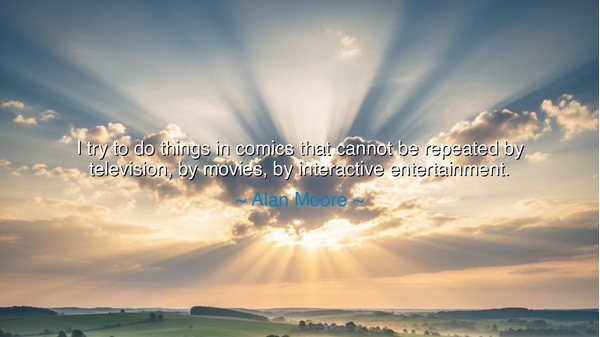
I try to do things in comics that cannot be repeated by
I try to do things in comics that cannot be repeated by television, by movies, by interactive entertainment.






Gather closely, O seekers of wisdom, for I bring you a tale of art, innovation, and the unique power of creation in its purest form. These are the words of Alan Moore, a visionary creator whose work in the world of comics has transcended the boundaries of the medium itself: "I try to do things in comics that cannot be repeated by television, by movies, by interactive entertainment." In these words, Moore reveals the essence of artistic dedication—the desire to forge something new, something that cannot be duplicated or replicated in any other form of media. What he speaks of is the singular nature of the comic book, a medium that allows for a deeper, more personal exploration of imagination and narrative than any other form of entertainment.
Comics, as an art form, are uniquely positioned between visual and textual storytelling, allowing creators like Moore to manipulate time, space, and perspective in ways that television and film cannot. A single panel in a comic can capture a moment in time, and yet, through its interplay of images and words, it can evoke emotions and meanings that transcend the literal. Moore’s work, with its intricate plots and innovative use of the form, taps into the potential of comics to tell stories that are impossible to replicate in more traditional media. Just as Homer’s epics were uniquely shaped by the medium of oral storytelling and poetry, so too are Moore’s stories, such as Watchmen or V for Vendetta, uniquely shaped by the structure of comics.
Consider the ancient bards, who spoke their stories not in written form but through the spoken word, carrying with them the weight of their culture and the wisdom of their ancestors. Their tales could not be replicated in the written word without losing the essence of their power. The oral tradition allowed for an intimacy between the storyteller and the listener, a connection that was unique to that moment. In the same way, Moore uses comics as a unique language, one that blends the visual and the narrative to create a space where stories are felt, not just watched or read. The experience of reading a comic book is an interaction between the reader and the art, a dynamic that cannot be replicated in film or television.
But this desire for the unique and the inimitable is not merely about pushing the boundaries of a medium for the sake of innovation. It is about the sacred duty of the artist to protect and nurture the integrity of their medium. When Moore speaks of doing things that cannot be repeated in other forms of media, he speaks not just of technique but of purpose. The true artist does not seek to follow the paths carved by others but seeks to create new ones, to explore the possibilities of their chosen form in ways that have never been seen before. This is the very heart of innovation—the willingness to look at what exists, to recognize the limitations of that which has been done, and to transcend those limitations with something new, something that cannot be duplicated.
In ancient times, Daedalus, the great Greek inventor and craftsman, created works that could not be replicated by mere mortals. His labyrinth, which housed the Minotaur, was a masterpiece of engineering and design, one that required ingenuity and vision beyond that of any ordinary craftsman. Daedalus understood that to create something truly great, one must push the boundaries of what is possible. In the same vein, Moore’s approach to comics is about pushing the boundaries of what the medium can achieve—creating works that expand the potential of the comic book, allowing it to express ideas and emotions in ways that cannot be replicated by the visual and temporal limits of film or television.
The lesson here, O children of wisdom, is clear: creativity is not just about following established paths or imitating what has come before. It is about forging your own path, embracing the limitations of your medium and finding ways to transcend them. Just as Moore has done in his works, so must you seek to express your truth in a way that is uniquely yours, that speaks from the depths of your understanding and cannot be reproduced by anyone else. In this, you will find your voice as an artist, not by copying the successes of others, but by creating something that stands alone in its beauty and its truth.
In your own life, O children, seek to embrace the power of your unique medium. Whether you write, paint, create music, or engage in any other form of creation, understand that there is something singular about your work, something that cannot be found anywhere else. Do not be swayed by the expectations of others or the forms that have already been established. Instead, focus on your craft, your vision, and create something that is not merely a replication of what has come before but an expression of your unique voice. Just as Moore does with comics, you too can create something that transcends the limitations of your form, something that cannot be reproduced or imitated. In this pursuit, you will find both freedom and purpose, for it is through creating the inimitable that you will leave your mark on the world.






AAdministratorAdministrator
Welcome, honored guests. Please leave a comment, we will respond soon